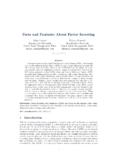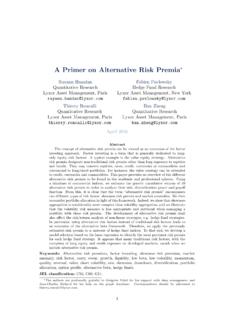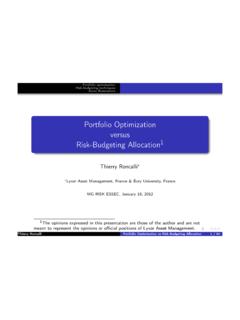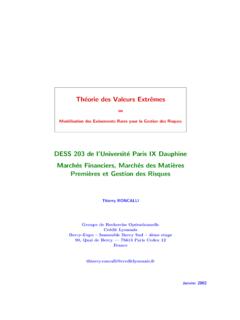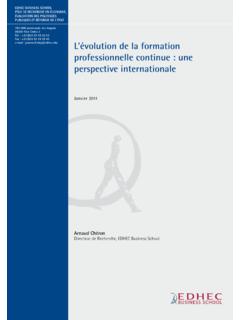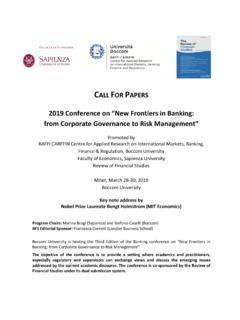Transcription of Measuring Performance of Exchange Traded Funds
1 Measuring Performanceof Exchange Traded Funds Marl ne HassineETF StrategyLyxor Asset Management, RoncalliResearch & DevelopmentLyxor Asset Management, 2013 AbstractFund selection is an important issue for investors. This topic has spawned abundantacademic literature. Nonetheless, most of the time, these works concern only activemanagement, whereas many investors, such as institutional investors, prefer to invest inindex Funds . The tools developed in the case of active management are also not suitablefor evaluating the Performance of these index Funds . This explains why informationratios are usually used to compare the Performance of passive Funds . However, weshow that this measure is not pertinent, especially when the tracking error volatility ofthe index fund is small.
2 The objective of an Exchange Traded fund (ETF) is preciselyto offer an investment vehicle that presents a very low tracking error compared to itsbenchmark. In this paper, we propose a Performance measure based on the value-at-riskframework, which is perfectly adapted to passive management and ETFs. Dependingon three parameters ( Performance difference, tracking error volatility and liquidityspread), this efficiency measure is easy to compute and may help investors in theirfund selection process. We provide some examples, and show how liquidity is more ofan issue for institutional investors than retail :Passive management, index fund, ETF, information ratio, tracking error, liq-uidity, spread, IntroductionThe market portfolio concept has a long history and dates back to the seminal work ofMarkowitz (1952).
3 In that paper, Markowitz defines precisely what portfolio selection means: the investor does (or should) consider expected return a desirable thing and variance of re-turn an undesirable thing . Indeed, Markowitz shows that an efficient portfolio is a portfoliothat maximizes the expected return for a given level of risk (corresponding to the varianceof return). Markowitz concludes that there is not only one optimal portfolio, but a set ofoptimal portfolios called the efficient frontier (represented by the solid blue curve in Figure1). By studying liquidity preference, Tobin (1958) shows that the efficient frontier becomes a We are profoundly grateful to Bou Ly Wu for his support with data management and the computationof liquidity spreads on limit order books. We would also like to thank Arnaud Llinas, Rapha l Dieterlen,Val rie Lalonde, Fran ois Millet and Matthieu Mouly for their helpful Performance of Exchange Traded Fundsstraight line in the presence of a risk-free asset.
4 If we consider a combination of an optimizedportfolio and the risk-free asset, we obtain a straight line (represented by the dashed blackline in Figure1). But one straight line dominates all the other straight line and the efficientfrontier. It is called the Capital Market Line (CML), which corresponds to the green dashedline in Figure1. In this case, optimal portfolios correspond to a combination of the risk-free asset and one particular efficient portfolio named the tangency portfolio. Sharpe (1964)summarizes the results of Markowitz and Tobin as follows: the process of investment choicecan be broken down into two phases: first, the choice of a unique optimum combination ofrisky assets; and second, a separate choice concerning the allocation of Funds between sucha combination and a single riskless asset.
5 This two-step procedure is today known as theSeparation of the difficulties faced when computing the tangency portfolio is that of preciselydefining the vector of expected returns of the risky assets and the corresponding covari-ance matrix of returns. In 1964, Sharpe developed the CAPM theory and highlighted therelationship between the risk premium of the asset (the difference between the expectedreturn and the risk-free rate) and its beta (the systematic risk with respect to the tangencyportfolio). Assuming that the market is at equilibrium, he showed that the prices of assetsare such that the tangency portfolio is the market portfolio, which is composed of all riskyassets in proportion to their market capitalization. That is why we use the terms, tangencyportfolio and market portfolio indiscriminately 1:Efficient frontier and the tangency portfolioAnother step forward was made by Jensen (1968), who measured the Performance of 115(equity) mutual Funds using the alpha measure and concluded that: The evidence on mutual fund Performance indicates not only that these 115mutual Funds were on average not able to predict security prices well enough to2 Measuring Performance of Exchange Traded Fundsoutperform a buy-the-market-and-hold policy, but also that there is very littleevidence that any individual fund was able to do significantly better than thatwhich we expected from mere random chance.
6 The seminal work of Michael Jensen is the starting point of the development of passivemanagement. Indeed, the first index fund was launched in 1971 by John McQuown at WellsFargo Bank for the Samsonite luggage company (Bernstein, 1992). It took a long time forinvestors to accept the ideas of Markowitz, Sharpe and Jensen, but passive managementrepresents now a large part of the asset management industry as shown in 2:Index Funds share in the equity mutual fund market16%18%14%10%12%8%4%6%2%4%0%1997199 8199920002001200220032004200520062007200 8200920102011 There is an abundance of literature that compares the Performance of active , academics have developed many econometrics tools in this domain to measure theiralpha and their skill (Grinblatt and Titman, 1989; Blakeet al.)
7 , 1993; Carhart, 1997; Barraset al., 2010). Professionals have also created databases and ranking systems to evaluatemutual Funds . For instance, Morningstar is certainly one of the best known scoring literature is scarcer when it comes to Measuring the Performance of passive , one uses the same quantitative tools as those developed for passive managementto investigate the efficiency of an index fund. The aim of this paper is to provide moreappropriate tools for investor looking to invest in index Funds , and in Exchange Traded fundsin paper is organized as follows. Section 2 presents the efficiency measure, which is infact a risk measure. In particular, we describe the reasoning behind this indicator and itsrationale. Empirical results are reported in Section 3. In section 4, we consider differentvariations on the tracker efficiency measure.
8 For example, we consider other definitions ofthe risk measure and the liquidity spread. Finally, in Section 5 we draw our conclusions3 Measuring Performance of Exchange Traded Funds2 Measuring the efficiency of Exchange Traded Performance or efficiency measurement? Understanding fund picking in active managementFund picking could be summarized as a two-step procedures: Defining a universe of Funds , that are sensitive to certain risk factors; Picking one or more elements of this universe by combining quantitative and first step is crucial in order to define a universe of mutual Funds , that are sufficientlyhomogeneous in terms of risk analysis. For instance, if we want to invest in equities, itcould be useful to describe the universe more accurately. Does the investment concernglobal equities, regional equities or country equities?
9 Does the investment definition relate tospecific sectors, by focusing on or excluding some of them? What is the bias of the investmentuniverse in terms of style analysis? The capacity of the investor to clearly define the bordersof the universe is the most important part of the fund picking process, because the secondstep is relatively straightforward once the first step has been accurately completed. Forexample, investing in large capitalization equities located in the Eurozone that do not belongto the banking system, and are recognized as socially responsible, effectively reduces theuniverse to a small number of mutual , defining the investment universe is not always straightforward, for manyreasons. First, the category may be very large with numerous mutual Funds .
10 Suppose wewanted to invest in sovereign bonds in the Eurozone. According to the Morningstar databasethere are more than200such Funds available. Second, a category may not necessarily existif the criteria are too specific1. Third, investment styles are heterogeneous, because theycannot be defined in a precise way. Take value and growth styles, for example. Everybodyknows what they mean, but if we ask two people to classify the components of the S&P 500index according to growth/value risk factors, we will get two different answers. This showsthat investing in active management may have a significant cost, because thorough researchis necessary to find accurate information. That is why, in the end, many investments arebased on past Why is fund picking different with passive management?
